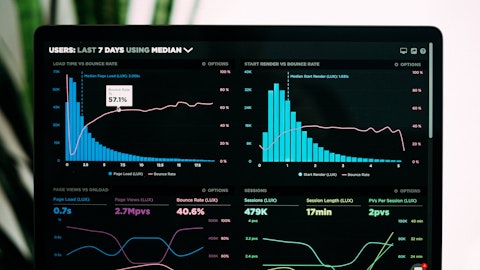William Lansing : We are seeing shortening. I mean the sales cycle a year ago was over a year long. And today, it’s 2/3 of that. We’re very happy with that progress. There’s a lot of reasons for it, but it’s kind of the cumulative effect of us moving out the process and scaling up, and things are going faster. I’d also say that the demand is really hot for our offering. The customers are really interested and they’re in a hurry to get it going. And it’s pretty easy for us to get it up and live. So all those things have contributed to a shorter sales process. And I would say that’s true overseas as well as in the U.S.
Seth Weber : Okay. And then maybe just going back to the expenses again for a second. The fourth quarter software expenses were a little higher than what we were expecting. Did that — does that already include some of these new investments that you’re talking to? Or will these investments be incremental to sort of this fourth quarter run rate?
Steven Weber : Yes. I mean it’s maybe a little bit incremental. We do have some onetime expenses, a lot of our — around incentives in the fourth quarter that ramps up. And a lot of our people are in software. So you’re going to see a little bit higher expense there. But our run rate is not going to increase significantly off of where we — our exit rate from the fourth quarter.
Operator: Your next question comes from the line of Jeff Meuler with Baird.
Jeff Meuler : Can you give us any sense of what you included in the guidance versus what you held back around pricing? For instance, last year, I think you talked about the original guide had the CPI-like pricing increases, but it didn’t have the specialty increases. Just any way to help us kind of like understand what’s assumed versus what could still be on the come?
William Lansing : Yes. Jeff, I know you’d love for us to put a number on it. And you know us, we never do. And so it’s not going to happen today either. The way we think about it is we look at the volumes, we make our forecast built around the volumes. We put on a CPI increase, and then we put what some people call special pricing, but we have some additional increases beyond CPI. And then because the timing of those is uncertain, we leave some of that out of the guidance. And so call our guidance conservative. It’s designed to reflect the fact that we just don’t know how quickly the full-price effect will be ramped into our numbers. And so I hesitate to put any kind of a number on it for you. Is it safe to think about it the way we have in years past? Yes. So think about it the way we do it every year. We haven’t changed our methodology.
Steven Weber : No, I would say the only change is that there’s probably more volatility in terms of volumes had in the past. So I mean, if you could tell me what the interest rate is going to be in 6 or 9 months, I could give you a better idea. But I don’t think anybody knows that.
Jeff Meuler : That’s right. Okay. And then I guess I was surprised to see the departure of Stephany just given how well software has been doing for a while now. Can you just comment on just any, I guess, reasoning why there’s a change now, when you expect to have a new leader announced, if they’re likely to come as an internal promotion, external? Just any perspective on that would be helpful.
William Lansing : Yes. Stephanie has done a great job with us. She’s done a lot of good things for FICO and for the software business in particular. She decided to pursue other professional opportunities, and so we wish her well with all that. We — FICO graduates a lot of talent. I mean it’s not — Stephanie is not the first talent who’s left us. And we have a really strong team, and I’m confident that our software business will continue very smoothly. In terms of leadership, I’m taking over the leadership of the software business directly, so — which is what I did before Stephanie took it over. And so I’m pretty comfortable with that. Might we have another leader besides me in the future? We might, but that’s not the plan right now. So I’m going to run it for the time being, and we’ll see.
Operator: [Operator Instructions] The next question comes from the line of Manav Patnaik with Barclays.
Manav Patnaik : Will, just on the software side, I mean, a lot of good numbers this quarter. You talked a lot about the visibility going into next year. So maybe just help us in terms of the ’24 guidance. How should we think about the components of the software growth in there?
William Lansing : Software business is growing double digit just like the scores business. I mean it’s very strong. And where — it continues to be strong. Where we haven’t decelerated in any way in terms of our platform growth rates, which, as you know, were very high. And we — trees don’t grow to the sky, but we expect that to continue for quite some time. I mean there’s a lot of demand. The pipeline this year is stronger even than a year ago. And so yes, we’re very optimistic.
Steven Weber : And Manav, the business has changed a lot from the days when we had — when we were relying on term licenses. So now a lot of the deals — a lot of the revenue we have visibility to because of the deals are already signed, right? We’re just implementing them. So we’ll be standing up more of these — the recurring revenue in the coming quarters. So we have pretty good line of sight to that. And then there’s still a lot of people who are working with from the customer success side to expand their usage. So we’re far less dependent on making sure we sign deals at the end of the quarter to pull revenue in.
Manav Patnaik : Got it. And then, Steve, in looking at the EPS guidance, can you just talk about the assumptions there on — just help us out with share count. I don’t think you include additional buybacks, interest expense and maybe any other items that could change year-over-year.





